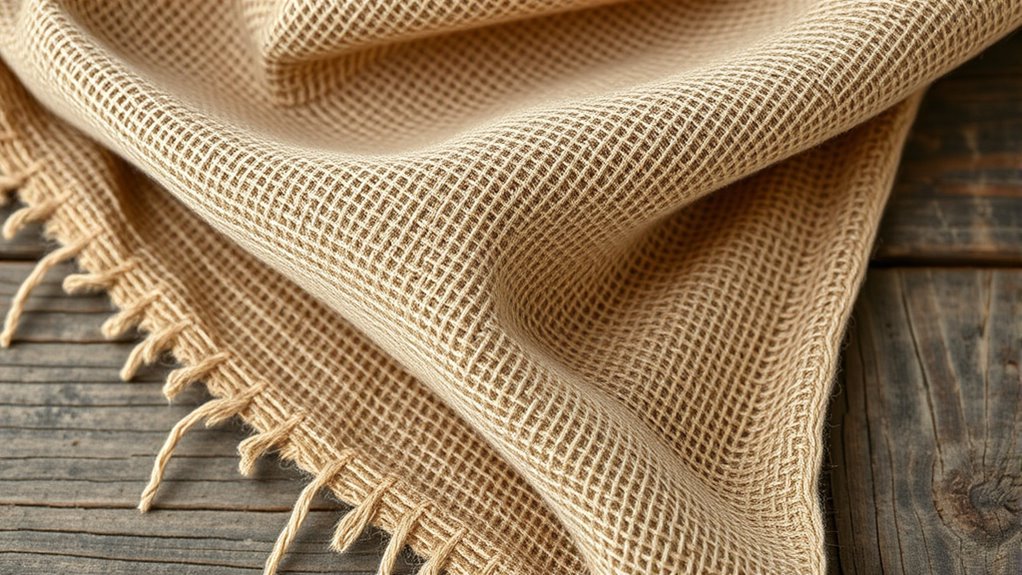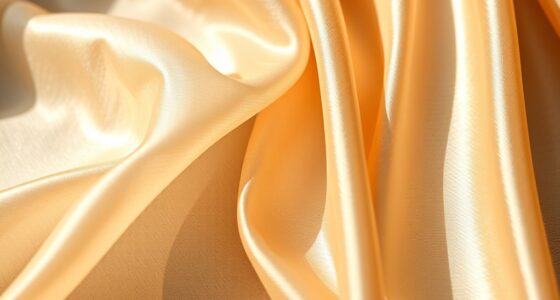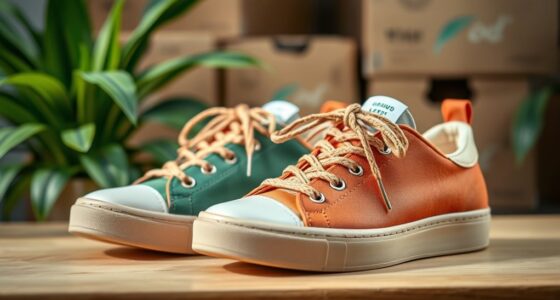Hemp fabric is an eco-friendly, durable, and natural material that supports sustainable sourcing and grows quickly without pesticides or synthetic fertilizers. It’s naturally resistant to pests, mold, and dirt, which reduces the need for harmful chemicals and frequent washing. Care tips include using cold water, air drying, and avoiding harsh detergents to maintain its strength. Exploring further reveals how hemp’s benefits make it a smart choice for eco-conscious lifestyles and fashion.
Key Takeaways
- Hemp fabric is environmentally sustainable, grows rapidly without pesticides, and requires fewer resources than traditional textiles.
- It is often dyed with eco-friendly methods, reducing water pollution and chemical runoff.
- Naturally resistant to pests and mold, hemp fabric is durable and needs less chemical treatment, extending garment lifespan.
- Easy to care for: wash with cold water, air dry, and avoid harsh detergents to maintain its quality.
- Hemp fabric is biodegradable and recyclable, supporting waste reduction and environmental health.

Hemp fabric is gaining popularity as a sustainable and durable alternative to traditional textiles. When you choose hemp, you’re supporting sustainable sourcing practices that minimize environmental impact. Hemp grows quickly without the need for pesticides or synthetic fertilizers, making it an eco-friendly crop. This rapid growth cycle means you get a renewable resource that doesn’t deplete soil nutrients or contribute to deforestation. By opting for hemp fabric, you’re making a conscious decision to reduce your carbon footprint, as its production generates fewer greenhouse gases compared to conventional cotton or synthetic fibers.
Choosing hemp supports eco-friendly sourcing and reduces environmental impact through sustainable, pesticide-free growth.
In addition to its sustainable sourcing, hemp fabric is often produced using eco friendly dyeing methods. Traditional dyeing processes can involve toxic chemicals that pollute waterways and harm ecosystems. However, many manufacturers now adopt eco friendly dyeing techniques, utilizing natural or low-impact dyes that are safer for the environment. When you select hemp garments dyed with eco friendly methods, you’re supporting industries that prioritize environmental health. This not only results in less pollution but also ensures that the dyes are less likely to cause skin irritations or allergic reactions, making the fabric safer for you.
Hemp fibers are naturally resistant to pests and mold, reducing the need for chemical treatments during cultivation and processing. This means fewer chemicals end up in the environment and your clothing is free from potentially harmful residues. The durability of hemp fabric means your clothes will last longer, which further reduces waste and the demand for fast fashion. Its strength and resistance to wear make it an excellent choice for everyday use, from casual wear to outdoor gear.
Caring for hemp fabric is straightforward. Because it’s naturally resistant to dirt and stains, you won’t need to wash it as often, which conserves water and energy. When you do wash your hemp items, use cold water and a gentle cycle to preserve their integrity. Avoid harsh detergents and opt for eco friendly laundry products to keep the fabric in top condition. Air drying is ideal, as it prevents shrinkage and maintains the fabric’s strength. If you need to iron, use a low heat setting, and avoid using chemical fabric softeners that can degrade the fibers over time. Additionally, understanding the recyclability and biodegradability of hemp fabric underscores its environmental benefits, as it can break down naturally without leaving harmful residues.
Frequently Asked Questions
Is Hemp Fabric Suitable for Allergy-Prone Skin?
Yes, hemp fabric is suitable for allergy-prone skin. Its natural, hypoallergenic properties make it a great choice for those with skin sensitivity or allergies. Hemp’s breathable and moisture-wicking qualities help reduce irritation and prevent allergic reactions. You’ll find that wearing hemp can minimize allergy considerations, offering comfort and protection, especially if you have sensitive skin. Just verify the hemp is untreated or organic for the best skin-friendly results.
Can Hemp Fabric Be Recycled or Composted?
Yes, hemp fabric can be recycled and composted. Recycling processes break down hemp fibers, allowing you to reuse or repurpose the material, reducing waste. Composting hemp offers significant benefits, as it naturally decomposes into nutrient-rich soil, supporting sustainability. By composting hemp, you contribute to eco-friendly waste management and close the loop in textile use, making it an environmentally responsible choice that benefits your garden and the planet alike.
How Does Hemp Fabric Compare to Organic Cotton?
Hemp fabric generally outperforms organic cotton in durability and eco-friendliness. It’s stronger and more resistant to wear, making it ideal for long-lasting clothes. Plus, hemp absorbs eco-friendly dyes better, reducing environmental impact. When compared to organic cotton, hemp requires less water and pesticides during cultivation, making it a more sustainable choice. Overall, hemp offers superior textile durability and a more eco-friendly profile, perfect if you’re aiming for eco-conscious fashion.
Are There Any Environmental Concerns With Hemp Cultivation?
Ever wonder if hemp cultivation harms the environment? While hemp is generally eco-friendly, concerns exist about sustainable farming practices and water usage. Some farmers might overuse water, impacting local resources, but overall, hemp requires less water and fewer pesticides than many crops. By choosing sustainably farmed hemp, you help reduce environmental impact. Isn’t it worth supporting practices that promote eco-conscious farming and conserve water?
What Are the Best Ways to Upcycle Old Hemp Clothing?
You can upcycle your old hemp clothing by doing DIY repairs like patching holes or adding embellishments to give it a fresh look. Get creative with dyeing—try creative dyeing techniques like tie-dye or dip-dye to transform faded pieces into vibrant new styles. These methods not only extend your garment’s life but also let you express your personal style while reducing waste.
Conclusion
By choosing hemp fabric, you’re supporting a sustainable and eco-friendly material that requires 50% less water to produce than cotton. Its durability and biodegradability make it a smart, long-lasting choice. With proper care, hemp fabric can last for years, reducing waste and your environmental footprint. Embrace hemp and contribute to a greener planet—every piece you wear helps reduce the 92 million tons of textile waste generated globally each year.









